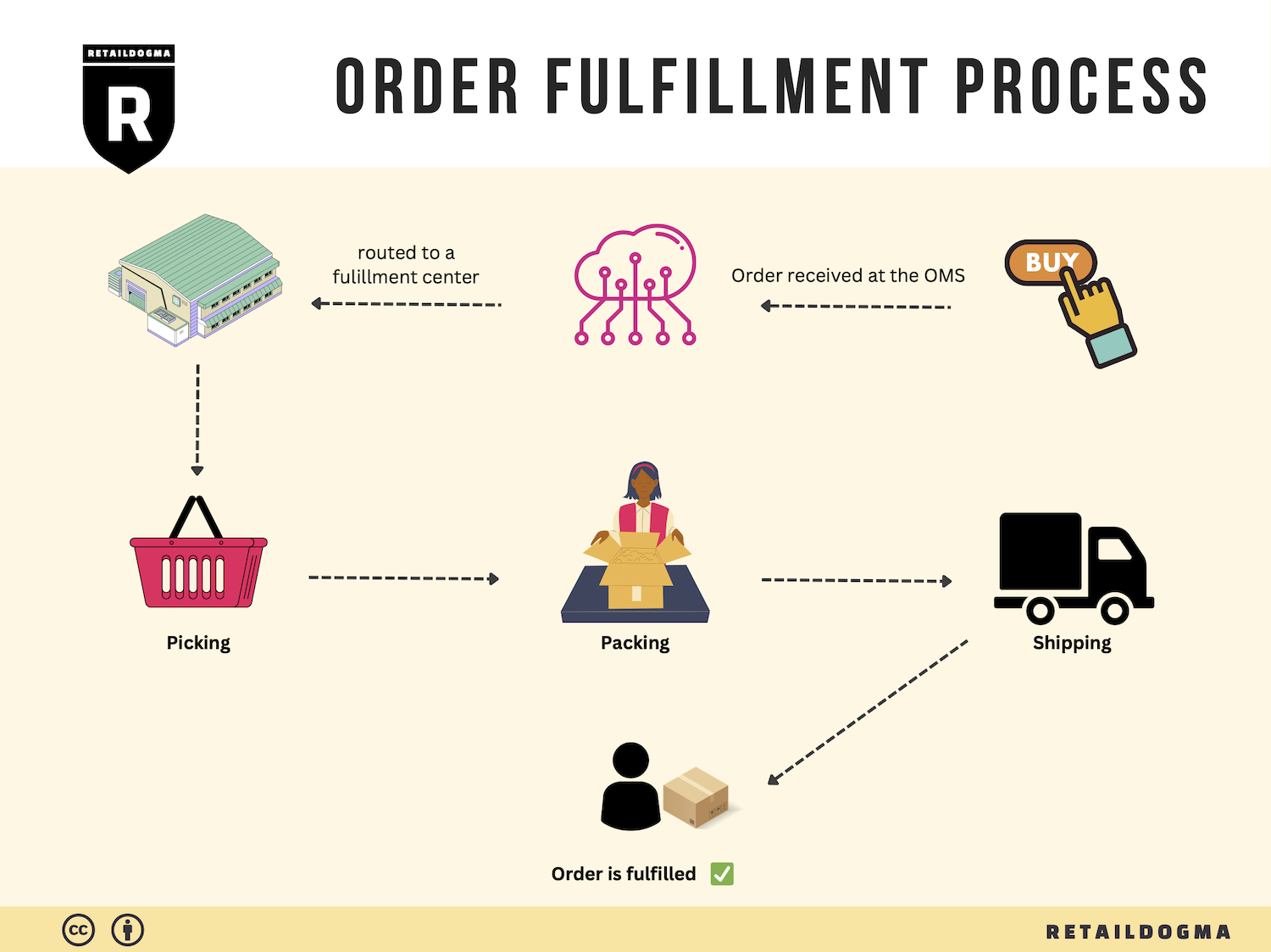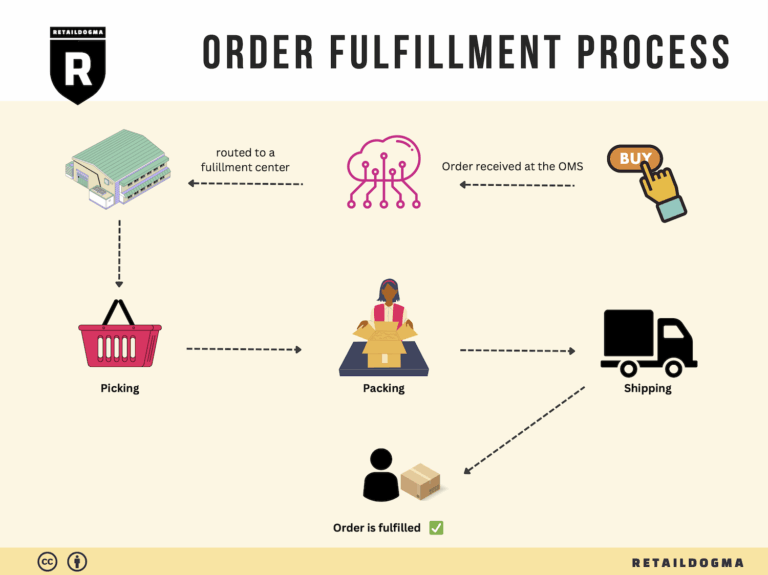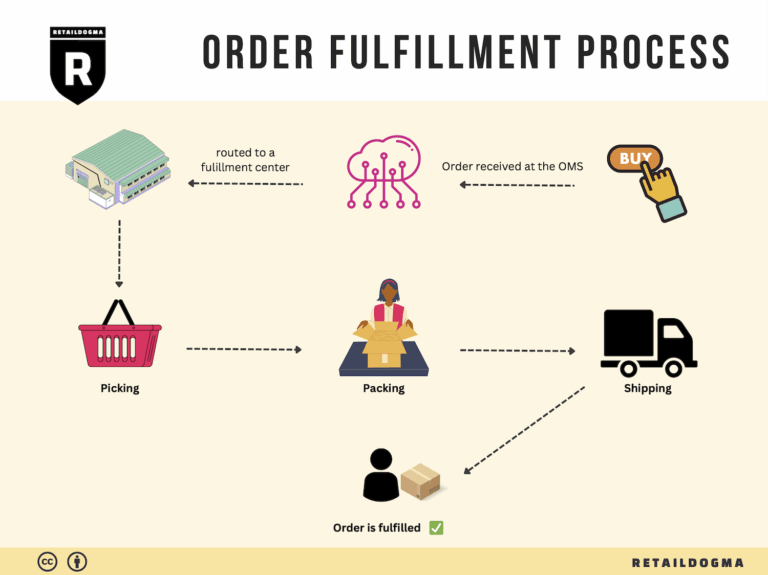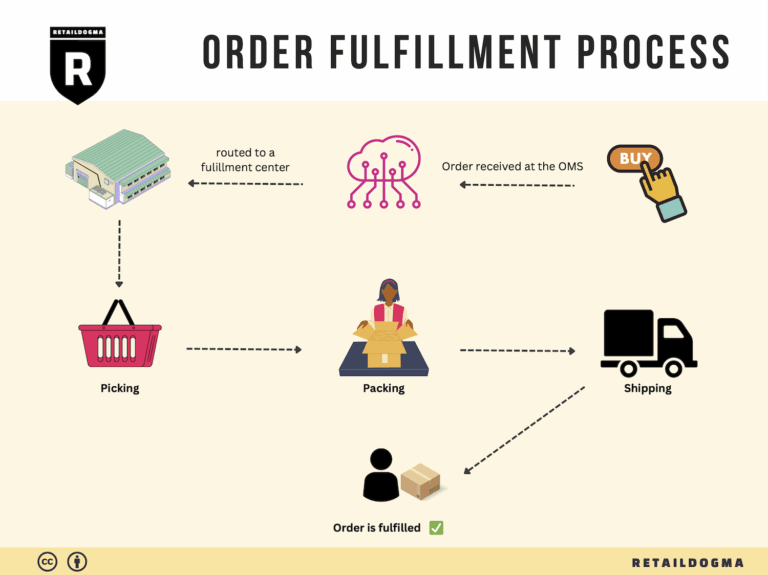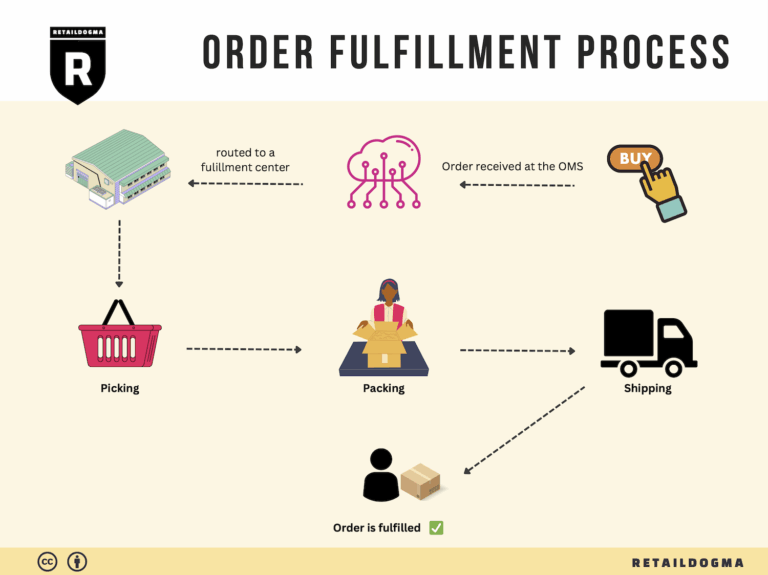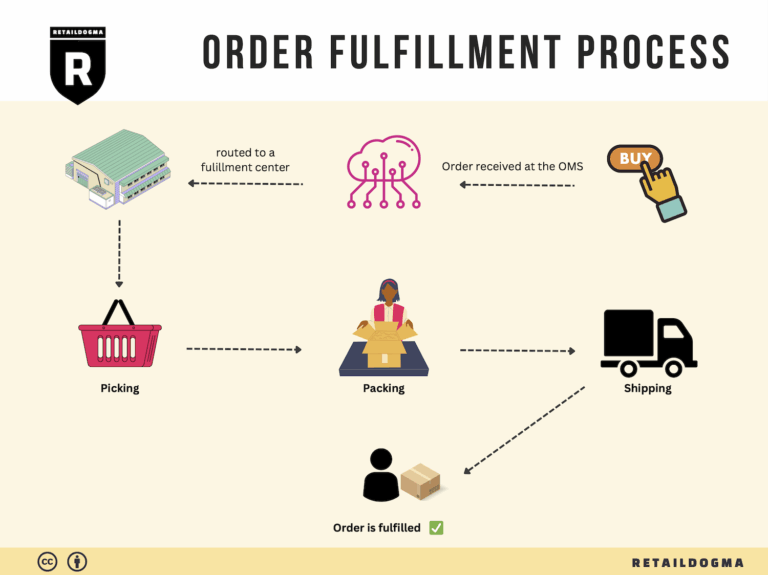Ecommerce Fulfillment Services: The Ultimate Guide (2025)
What is E-commerce Fulfillment? An Introduction for Growing Businesses
Understanding E-commerce Fulfillment: A Vital Component for Growth
As an e-commerce business owner, you may find yourself grappling with a common challenge: the overwhelming task of packing and shipping orders. Managing the logistics of getting products into the hands of customers can quickly become a daunting task, especially as your sales volume increases. This is where e-commerce fulfillment comes into play—a critical process that encompasses everything from inventory management to order processing and shipping.
At its core, fulfillment is the systematic process of getting a product from your warehouse to your customer’s doorstep. It involves a series of steps, including receiving and storing inventory, picking and packing orders, and managing shipping logistics. Understanding this process is crucial for scaling your business and ensuring customer satisfaction.
In this guide, we will explore the various fulfillment models available to e-commerce businesses, such as Third-Party Logistics (3PL) and Fulfillment by Amazon (FBA). Each model has its unique advantages and challenges, and knowing which option aligns best with your business goals is essential.
Additionally, we’ll delve into the core services offered by fulfillment providers. These services often include inventory management, order processing, shipping, returns management, and even customer service support. Knowing what to expect from your fulfillment partner will help you make informed decisions.
Choosing the right fulfillment partner is another critical aspect we’ll cover. The selection process involves evaluating factors such as compatibility with your business model, quality control measures, technological capabilities, and experience in the apparel sector, among others. A well-chosen partner can significantly streamline your operations and enhance your customer experience.
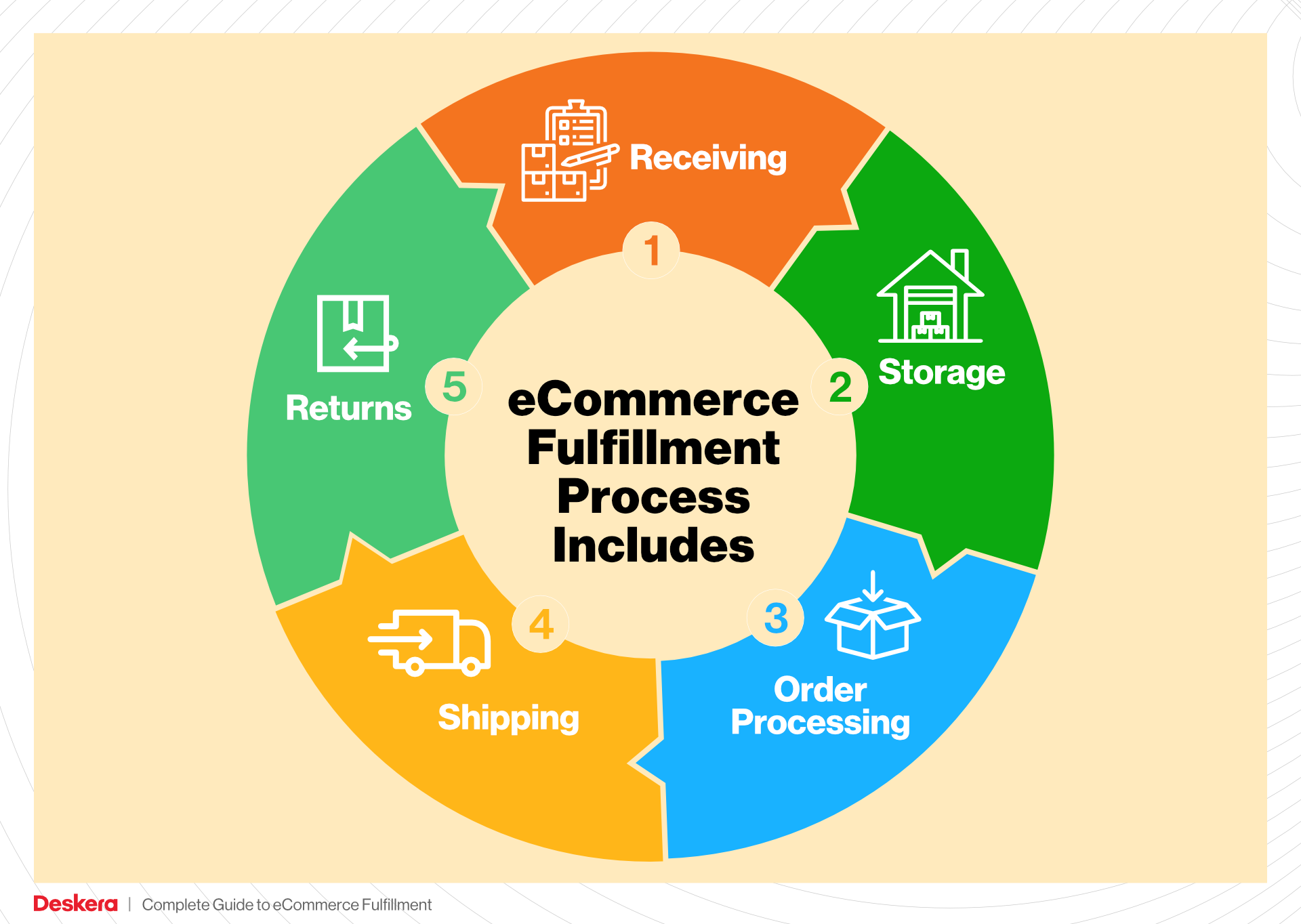
Finally, we will discuss pricing strategies and what to consider when budgeting for fulfillment services. Understanding the cost structure—whether it’s based on storage, handling, or shipping—can help you manage your bottom line effectively.
The ultimate goal of this guide is to empower you as a business owner to make informed, strategic decisions about your logistics. By understanding the ins and outs of e-commerce fulfillment, you can enhance your operational efficiency, reduce costs, and ultimately provide a better experience for your customers. Let’s dive in and explore how you can optimize your fulfillment strategy for sustainable growth.
What You’ll Learn In This Guide
- What is E-commerce Fulfillment? An Introduction for Growing Businesses
- The Order Fulfillment Process: From ‘Buy’ Button to Customer’s Door
- Comparing Fulfillment Models: In-House vs. 3PL vs. Dropshipping
- A Deep Dive into Amazon FBA: Pros, Cons, and Who It’s For
- Core Services Offered by Fulfillment Centers
- How to Choose a Fulfillment Partner: A 6-Point Checklist
- Understanding Fulfillment Pricing: A Breakdown of Common Fees
- Frequently Asked Questions (FAQs) about Fulfillment
- Conclusion: Is Outsourcing Fulfillment the Right Move for Your Business?
- Important Disclaimer
The Order Fulfillment Process: From ‘Buy’ Button to Customer’s Door
1. Receiving Inventory
The first step in the order fulfillment process is receiving inventory, where products are delivered to your fulfillment center or warehouse from suppliers or manufacturers. During this phase, it’s crucial to conduct thorough inspections to ensure that the received items match the purchase orders in terms of quantity and quality. This step often involves recording information such as Stock Keeping Units (SKUs), which are unique identifiers for each product variant.
Importance: Proper inventory receiving is essential to maintaining accurate stock levels and preventing discrepancies that can lead to order fulfillment errors. Any issues identified during this phase can be addressed before products are stored, reducing the risk of returns and customer dissatisfaction later on.
Key Term: SKU (Stock Keeping Unit) – A unique identifier for each product variant, which aids in inventory tracking and management.
2. Warehouse Storage
Once the inventory is received and inspected, it is stored in designated areas within the warehouse. Effective warehouse storage solutions involve organizing products logically and efficiently, often by categorizing them based on factors like product type, demand frequency, or size. This organization facilitates easier access and reduces the time it takes to fulfill orders.
Importance: An optimized storage system is vital for quick retrieval of products when orders come in. Efficient warehouse storage not only minimizes the time spent locating items but also reduces the likelihood of errors in picking the wrong items, which can negatively impact customer satisfaction.
Key Term: ABC Analysis – A method of inventory categorization that prioritizes items based on their importance and sales volume, helping businesses focus on high-demand products.
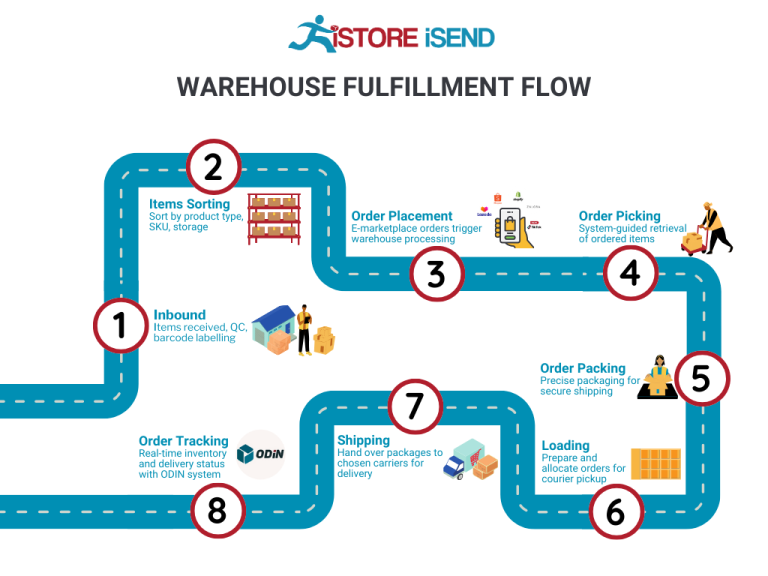
3. Order Picking
The order picking stage involves selecting the correct items from storage to fulfill customer orders. This process typically utilizes pick lists, which are documents or digital notifications detailing the items and quantities needed for each order. Depending on the size and complexity of the fulfillment operation, businesses may employ various picking methods, such as single-order picking, batch picking, or zone picking.
Importance: Efficient order picking is crucial for meeting customer expectations regarding shipping speed. The faster and more accurately items are picked, the quicker they can be packed and shipped, leading to improved customer satisfaction and loyalty.
Key Term: Pick List – A document that outlines the items to be collected from the warehouse to fulfill specific customer orders, ensuring accuracy and efficiency in the picking process.
4. Order Packing
After picking, the next step is order packing, where the selected items are carefully packed for shipment. This process often involves choosing the right packaging materials, which can include boxes, bubble wrap, and protective fillers, to ensure that products arrive at the customer’s door in excellent condition. Additionally, packing slips and shipping labels are generated and included in the package.
Importance: Proper packing is essential not only for protecting the items during transit but also for presenting a professional image to the customer. Well-packed orders can enhance the unboxing experience, fostering brand loyalty and encouraging repeat purchases.
Key Term: Packing Slip – A document that accompanies the shipment, listing the items included in the order, serving as a confirmation for both the business and the customer.

5. Shipping & Delivery
The final step in the order fulfillment process is shipping and delivery, where the packed orders are dispatched to customers. This phase includes selecting appropriate shipping carriers based on factors like cost, speed, and reliability. Additionally, businesses can provide customers with tracking information to keep them informed about their order status.
Importance: Timely shipping is a significant factor in customer satisfaction. In today’s competitive e-commerce landscape, consumers expect quick delivery times. Efficient shipping processes not only help meet these expectations but also reduce operational costs through optimized carrier partnerships.
Key Term: Last-Mile Delivery – The final step in the shipping process where the product is delivered from a distribution center to the customer’s doorstep, often considered the most critical and costly part of logistics.
By understanding and optimizing each step of the order fulfillment process, apparel businesses can enhance their operational efficiency, improve customer satisfaction, and ultimately drive growth in their e-commerce ventures.
Comparing Fulfillment Models: In-House vs. 3PL vs. Dropshipping
Fulfillment Model Comparison
| Model | Who Handles Inventory | Best For (Business Stage) | Key Advantage | Key Disadvantage |
|---|---|---|---|---|
| In-House Fulfillment | Your own team | Established brands with stable demand | Greater control over inventory and fulfillment process | Higher operational costs and resource demands |
| Third-Party Logistics (3PL) | A third-party provider | Growing brands looking to scale | Cost-effective, scalable, and experienced support | Potential loss of control over customer experience |
| Dropshipping | Supplier/manufacturer | Startups and niche brands | Minimal upfront investment and risk | Lower margins and less control over inventory |
In-House Fulfillment
In-house fulfillment involves managing your own inventory and shipping processes within your organization. This model is best suited for established brands that have a stable demand and can afford the resources necessary to maintain a warehouse and logistics operations. The key advantage of in-house fulfillment is the level of control it offers. Businesses can directly oversee inventory management, packaging, and shipping processes, ensuring that their brand standards are upheld at every step. This model allows for tailored customer experiences, as businesses can implement specific quality control measures and packaging options that resonate with their brand identity. However, in-house fulfillment comes with significant drawbacks, including higher operational costs and the need for substantial resources, such as staff, warehousing space, and technology. As a business scales, maintaining in-house fulfillment can become increasingly complex and resource-intensive, making it essential to evaluate whether this approach aligns with long-term growth strategies.
Third-Party Logistics (3PL)
Third-party logistics (3PL) providers offer a comprehensive suite of services that include inventory storage, order fulfillment, and shipping, allowing businesses to outsource their logistics needs. This model is particularly advantageous for growing brands looking to scale without the burden of managing logistics in-house. The key advantage of using a 3PL is cost-effectiveness; these providers often have established relationships with carriers, enabling them to negotiate better shipping rates. Additionally, 3PLs are equipped to handle fluctuations in demand, making it easier for businesses to scale operations up or down as needed. They also bring expertise in inventory management, order processing, and returns handling, which can significantly enhance operational efficiency. However, one of the main disadvantages is the potential loss of control over the customer experience. Since the fulfillment process is outsourced, businesses may face challenges in maintaining the same level of service quality that customers expect. Selecting the right 3PL partner is crucial; businesses must ensure that the provider aligns with their operational needs and brand values.
Dropshipping
Dropshipping is a fulfillment model where the retailer does not hold inventory. Instead, when a customer makes a purchase, the retailer forwards the order to a supplier or manufacturer, who then ships the product directly to the customer. This model is particularly suitable for startups and niche brands with limited capital, as it requires minimal upfront investment and significantly reduces financial risk. The key advantage of dropshipping is its low operational overhead—businesses do not need to invest in inventory or warehousing, allowing them to focus on marketing and customer acquisition. Additionally, dropshipping provides flexibility to experiment with various products without the commitment of holding stock. However, the model also has notable disadvantages. Margins tend to be lower compared to in-house or 3PL fulfillment, as suppliers take a cut of the sales. Furthermore, businesses have limited control over inventory levels, shipping times, and product quality, which can lead to inconsistent customer experiences. As a result, while dropshipping can be a low-risk entry point into e-commerce, it may not be sustainable long-term for brands aiming to build a loyal customer base.
A Deep Dive into Amazon FBA: Pros, Cons, and Who It’s For
Understanding Fulfillment by Amazon (FBA)
Fulfillment by Amazon (FBA) is a service provided by Amazon that allows sellers to store their products in Amazon’s fulfillment centers. Amazon then takes care of storage, packaging, shipping, and customer service, including handling returns. This service is particularly appealing to e-commerce businesses looking to leverage Amazon’s vast logistics infrastructure and customer base.
How FBA Works
-
Product Listing: Sellers create listings for their products on Amazon. They can choose to enroll their products in FBA during the listing process.
-
Inventory Shipment: Sellers send their products to Amazon’s fulfillment centers. Amazon provides guidelines on how to package and label the products to ensure they are ready for storage and fulfillment.
-
Storage: Once received, Amazon stores the products in its warehouses. Sellers are charged storage fees based on the space their products occupy.
-
Order Fulfillment: When a customer places an order, Amazon picks, packs, and ships the product on behalf of the seller. This process is often very efficient, as Amazon has optimized its logistics to ensure rapid delivery.
-
Customer Service: Amazon also manages customer inquiries and returns related to FBA products, allowing sellers to focus on other aspects of their business.
-
Payment: After the sale is made, Amazon deducts fees for FBA services from the seller’s account and transfers the remaining balance to the seller.
Pros of Fulfillment by Amazon (FBA)
-
Prime Eligibility: Products fulfilled by Amazon are eligible for Amazon Prime, which significantly increases visibility and attractiveness to customers who prefer fast, reliable shipping. Prime members are more likely to purchase products that offer free two-day shipping.
-
Customer Trust: Selling through FBA can enhance a seller’s credibility. Customers often trust Amazon’s logistics and customer service, which can lead to higher conversion rates and reduced cart abandonment.
-
Multi-Channel Fulfillment: FBA allows sellers to fulfill orders not only from Amazon but also from other sales channels, such as their own websites or other marketplaces. This flexibility can streamline operations and reduce logistics complexities.
-
Scalability: Using FBA enables sellers to scale their businesses rapidly without the need for investing heavily in logistics infrastructure. Amazon’s fulfillment network handles the heavy lifting, allowing sellers to focus on marketing and sales growth.
-
Simplified Returns Management: Amazon handles all returns for FBA products, making it easier for sellers to manage customer service issues related to returns, which can be particularly high in the apparel industry.
Cons of Fulfillment by Amazon (FBA)
-
High Fees: FBA comes with various fees, including storage fees for inventory and fulfillment fees for each order shipped. These costs can add up, especially for slow-moving items, and can significantly impact profit margins.
-
Strict Inventory Rules: Amazon has strict guidelines regarding inventory management, including limits on storage space and the requirement to remove or destroy unsold inventory after a certain period. This can pressure sellers to constantly monitor their stock levels and sales performance.
-
Commingling Risks: Amazon may commingle inventory from different sellers to streamline fulfillment. This means that products from multiple sellers can be stored together, which can lead to issues if a seller’s product is mixed with others, potentially impacting brand reputation and quality control.
-
Loss of Control: By outsourcing fulfillment to Amazon, sellers lose some control over how their products are handled and shipped. This lack of oversight can be concerning, especially for brands that prioritize packaging and presentation.
-
Complexity in Returns: While Amazon handles returns, this can also lead to complications in tracking returned inventory and managing restocking, particularly for sellers who rely on detailed inventory management processes.
Who is FBA Best For?
Fulfillment by Amazon is particularly suitable for:
-
Emerging Brands: New e-commerce businesses that lack the infrastructure to manage logistics effectively can benefit significantly from FBA. It allows them to leverage Amazon’s existing systems without the upfront investment in warehousing and staff.
-
High-Volume Sellers: Businesses that have a large volume of sales or seasonal spikes in demand can benefit from Amazon’s extensive fulfillment capabilities, ensuring timely delivery and customer satisfaction.
-
Sellers of Standardized Products: For sellers of non-unique, standardized products (e.g., electronics, household items), FBA can be a great fit as it minimizes the risks associated with brand differentiation.
-
Brands Looking to Enter New Markets: FBA provides a pathway for brands to reach customers in different regions without the need for local fulfillment centers, thus expanding their market reach.
-
Businesses Focused on Growth: Companies looking to scale quickly while minimizing logistics headaches can find FBA an attractive option, as it allows them to focus on marketing and sales strategies rather than operational logistics.
In conclusion, Fulfillment by Amazon presents a compelling option for many e-commerce businesses, especially those in the apparel sector. While it offers numerous advantages in terms of speed, customer trust, and operational efficiency, potential sellers must weigh these benefits against the costs and constraints associated with the program. By understanding both the pros and cons, businesses can make informed decisions on whether FBA aligns with their growth strategies and operational capabilities.
Core Services Offered by Fulfillment Centers
Inventory Management & Warehousing
Inventory management and warehousing are foundational services provided by fulfillment centers, particularly for e-commerce businesses in the apparel sector. This service involves the systematic tracking of inventory levels, orders, sales, and deliveries. Fulfillment centers utilize advanced software and technology to monitor stock in real-time, ensuring businesses have accurate visibility of their inventory.
Benefits:
1. Reduced Stockouts and Overstocking: Efficient inventory management minimizes the risk of stockouts, which can lead to lost sales, while also preventing overstocking that incurs unnecessary storage costs.
2. Improved Cash Flow: By optimizing inventory levels, businesses can free up capital that would otherwise be tied up in unsold stock, allowing for better investment in growth opportunities.
3. Enhanced Forecasting: Fulfillment centers often provide analytics and insights into purchasing trends, enabling businesses to forecast demand more accurately and adjust their inventory strategies accordingly.
Pick and Pack Services
Pick and pack services refer to the process of selecting items from inventory (picking) and preparing them for shipment (packing). This service is crucial for e-commerce businesses, especially in the fast-paced apparel market, where timely fulfillment can significantly impact customer satisfaction.
Benefits:
1. Speedy Order Fulfillment: Fulfillment centers employ streamlined processes and technologies that enable quick picking and packing, ensuring orders are dispatched promptly to meet customer expectations for fast shipping.
2. Accuracy in Order Processing: Automated systems reduce the likelihood of human error in the picking process, which is vital in the apparel industry, where orders often include multiple SKUs across various sizes and styles.
3. Cost Efficiency: By outsourcing pick and pack services to fulfillment centers, businesses can reduce labor costs and save on the overhead associated with maintaining an in-house fulfillment operation.
Kitting and Assembly
Kitting and assembly services involve bundling multiple products together into a single package or preparing items for sale that require assembly. This is particularly relevant for apparel brands that offer sets, such as matching outfits or promotional bundles.
Benefits:
1. Enhanced Product Offerings: Kitting allows businesses to create unique product combinations that can attract customers and increase average order value. For instance, a clothing retailer might offer a complete outfit as a single SKU.
2. Streamlined Operations: By outsourcing kitting and assembly to fulfillment centers, businesses can focus on their core competencies—designing and marketing their products—while leaving the logistics to experts.
3. Reduced Time to Market: Quick and efficient kitting processes can significantly decrease the time it takes to bring new products to market, allowing brands to respond swiftly to trends and consumer demands.
Returns Management (Reverse Logistics)
Returns management, often referred to as reverse logistics, is a critical service offered by fulfillment centers, especially in the apparel industry, which has one of the highest return rates. This service encompasses the handling of returned merchandise, including processing, restocking, and managing the disposition of returned items.
Benefits:
1. Improved Customer Satisfaction: A streamlined returns process enhances the overall shopping experience for customers, making them more likely to shop again. Easy returns can be a key differentiator for apparel brands in a competitive market.
2. Cost Management: Efficient returns processing minimizes losses associated with returned goods by quickly assessing the condition of items and determining the best course of action—whether to restock, refurbish, or dispose of them.
3. Data-Driven Insights: Returns management systems often provide valuable data regarding customer preferences and common reasons for returns. This information can inform product development, inventory decisions, and marketing strategies, ultimately leading to improved sales performance.
In conclusion, partnering with a capable fulfillment center that offers these core services can significantly enhance an e-commerce apparel business’s operational efficiency, customer satisfaction, and overall profitability. As businesses scale, leveraging these services allows them to focus on their strategic goals while ensuring that logistics and fulfillment are handled proficiently.
How to Choose a Fulfillment Partner: A 6-Point Checklist
Location & Warehouse Network
Importance:
The location of your fulfillment partner’s warehouses is critical for ensuring timely delivery and minimizing shipping costs. A strategically located warehouse network can significantly reduce transit times, which is essential in meeting customer expectations for fast shipping.
Questions to Ask:
1. Where are your warehouses located, and how does that align with my target market?
2. Do you have multiple warehouses to facilitate faster shipping options?
3. What is your average shipping time from your warehouses to major metropolitan areas?
Technology & Integrations
Importance:
In today’s e-commerce landscape, technology plays a pivotal role in streamlining operations. A fulfillment partner that utilizes advanced technology can provide real-time inventory tracking, automate order processing, and integrate seamlessly with your existing systems, enhancing efficiency and reducing errors.
Questions to Ask:
1. What technology do you use for inventory management and order fulfillment?
2. Can your system integrate with my e-commerce platform (e.g., Shopify, WooCommerce)?
3. Do you offer real-time inventory updates and reporting capabilities?
Specializations (e.g., cold storage, oversized items)
Importance:
Different businesses have unique product requirements. If your apparel line includes specialty items—such as cold storage for certain fabrics or oversized items—it’s essential to partner with a fulfillment provider that has the necessary capabilities to handle these specific needs.
Questions to Ask:
1. Do you have experience handling my specific product types (e.g., delicate fabrics, oversized items)?
2. What special facilities do you have for items requiring temperature control or other specific handling?
3. Can you accommodate custom packaging or labeling for my products?
Scalability & Capacity
Importance:
As your business grows, your fulfillment needs will likely change. A good fulfillment partner should be able to scale operations up or down based on demand fluctuations, especially during peak seasons. This flexibility can prevent operational bottlenecks and ensure that customer service remains high.
Questions to Ask:
1. How do you manage peak season demands, such as during holidays or sales?
2. What is your capacity for handling sudden increases in order volume?
3. Can you provide examples of how you have scaled your operations for other clients?
Pricing and Contracts
Importance:
Understanding the pricing structure and contract terms is crucial for maintaining healthy profit margins. Look for transparency in pricing, including any hidden fees for storage, shipping, or order processing. A clear contract can prevent disputes and ensure a smooth working relationship.
Questions to Ask:
1. What is your pricing model (e.g., per order, per item, monthly fees)?
2. Are there any hidden fees I should be aware of?
3. What are the terms of the contract, and what is the process for terminating or renegotiating it?
Customer Support & Reviews
Importance:
Effective customer support can be a game-changer when issues arise. A responsive and knowledgeable support team can help you navigate challenges quickly, ensuring that your business runs smoothly. Additionally, reviews from current or past clients can provide insights into the reliability and quality of service offered.
Questions to Ask:
1. What customer support options do you offer (e.g., phone, chat, email)?
2. What are your average response times for support inquiries?
3. Can you provide references or reviews from current clients in my industry?
Conclusion
Choosing the right fulfillment partner is a critical decision that can significantly impact your apparel business’s success. By considering the above six points and asking the right questions, you can ensure that your chosen partner aligns with your operational needs and growth ambitions. Take the time to thoroughly evaluate potential partners to build a strong foundation for your e-commerce logistics strategy.
Understanding Fulfillment Pricing: A Breakdown of Common Fees
Initial Setup Fees
Initial setup fees are typically charged when you first engage with a fulfillment provider. This fee covers the costs associated with onboarding your business, including setting up your account, integrating your e-commerce platform, and configuring inventory management systems. Depending on the complexity of your operations, these fees can vary significantly.
To calculate initial setup fees, providers may consider factors such as the number of products you plan to sell, the intricacy of your inventory management needs, and any custom requirements you may have. For example, if your apparel brand requires specialized packaging or labeling, expect additional charges. It’s essential to ask for a detailed breakdown of these fees to understand what you’re paying for and to avoid unexpected costs.
Receiving Fees
Receiving fees are charged when your inventory arrives at the fulfillment center. This fee includes the cost of unloading, inspecting, and storing your products. Given the nature of apparel, where items come in various sizes and styles, the complexity of handling each shipment can affect the receiving fee.
Receiving fees are typically calculated based on the number of pallets or the total volume of goods received. Some providers may charge a flat rate per shipment, while others may base fees on the weight or dimensions of the products. To ensure transparency, request detailed information on how receiving fees are structured and any additional charges for handling damaged or mislabeled items.
Storage Fees (per pallet/bin)
Storage fees are incurred for the space your inventory occupies within the fulfillment center. These fees can be assessed on a per-pallet or per-bin basis, depending on how the provider structures their pricing.
Typically, storage fees are calculated on a monthly basis and can vary based on the type of products you are storing. For apparel businesses, where seasonal inventory turnover can be significant, understanding how storage fees scale with your inventory levels is crucial. Some providers offer tiered pricing, meaning the rate per pallet decreases as you store more inventory, while others may have a flat rate regardless of volume. Always clarify if there are additional charges for long-term storage, as holding inventory for extended periods can lead to increased costs.
Pick & Pack Fees (per item/order)
Pick and pack fees are charged for the labor involved in selecting items from inventory and packing them for shipment. This process is vital for ensuring orders are fulfilled accurately and efficiently, especially in the apparel sector, where multiple SKUs are common.
These fees are generally calculated on a per-item or per-order basis. A typical model might charge a flat fee for picking items and an additional fee for packing them, or a combined fee for both services. It’s important to inquire whether the fee structure changes based on the order size or complexity, as larger orders may have different pricing compared to single-item shipments. Additionally, some fulfillment centers may offer discounts for high-volume orders, so it’s worth discussing your expected order volume to negotiate better rates.
Shipping Fees
Shipping fees encompass the costs associated with transporting your products to customers. These fees can vary widely based on factors such as the destination, shipping method, package weight, and dimensions. Fulfillment providers often have negotiated rates with carriers, which can provide significant savings for your business.
To calculate shipping fees, providers typically use algorithms that take into account the weight and size of the package, the chosen shipping service (e.g., standard, expedited), and the delivery distance. It’s crucial to understand whether the shipping fees are included in your overall fulfillment costs or billed separately. Some fulfillment centers may offer flat-rate shipping options or the ability to pass on discounted rates, which can help manage your overall logistics expenses effectively.
Tips for Getting an Accurate Quote
-
Provide Detailed Information: When requesting quotes, be as specific as possible about your products, order volume, and fulfillment needs. This information allows providers to give you a more accurate estimate.
-
Ask for Itemized Pricing: Request a detailed breakdown of all fees associated with the fulfillment process. This transparency will help you understand the costs better and allow for easier comparison between providers.
-
Inquire About Volume Discounts: If you anticipate high order volumes, ask about any discounts available for bulk processing. Many providers are willing to negotiate rates based on expected order quantities.
-
Review Contract Terms: Before signing any agreements, carefully review the contract terms regarding fees, potential increases, and any penalties for changes in order volume or storage duration.
-
Consider Hidden Costs: Inquire about any additional charges that may arise, such as fees for returns, special handling, or seasonal fluctuations in pricing. Understanding the complete cost structure will help you make a more informed decision.
By taking these steps, you can ensure that you receive a comprehensive and accurate quote that aligns with your business needs and budget.
Frequently Asked Questions (FAQs) about Fulfillment
1. What is apparel fulfillment?
Apparel fulfillment refers to the entire process of storing, packaging, and shipping clothing products to customers. It encompasses inventory management, order processing, and returns handling, typically performed by third-party logistics providers (3PLs) or dedicated apparel fulfillment centers.
2. How do I choose the right fulfillment partner for my apparel business?
Selecting the right fulfillment partner involves assessing your business needs, including the type of apparel you sell, your target market, and your operational requirements. Look for a provider with experience in the apparel sector, robust quality control measures, real-time inventory management capabilities, and the ability to handle seasonal fluctuations in demand.
3. What’s the difference between a warehouse and a fulfillment center?
A warehouse primarily focuses on storing goods, while a fulfillment center specializes in preparing and shipping those goods to customers. Fulfillment centers often offer additional services like order processing, inventory management, and returns handling, which are essential for e-commerce businesses.
4. What is a 3PL?
A 3PL, or third-party logistics provider, is a company that manages logistics services on behalf of another business. This includes warehousing, inventory management, order fulfillment, and shipping. For apparel brands, partnering with a 3PL can streamline operations and help scale the business efficiently.
5. How much do fulfillment services cost?
Fulfillment service costs vary widely based on factors such as order volume, storage needs, and specific services required (like packaging and returns handling). Common pricing structures include per-order fees, storage fees, and shipping costs. It’s essential to request quotes from multiple providers to understand your potential expenses.
6. What are the benefits of using a fulfillment partner?
Using a fulfillment partner can enhance customer satisfaction by providing faster shipping, reducing operational costs, improving inventory management, and minimizing errors in order fulfillment. Additionally, a good partner can offer insights into customer preferences and purchasing patterns, aiding in strategic decision-making.
7. How can I manage returns effectively in apparel fulfillment?
Effective returns management in apparel fulfillment includes having a clear returns policy, utilizing a 3PL that can handle returned goods, and integrating a system that tracks returns to minimize losses. A streamlined returns process can enhance customer satisfaction and encourage repeat purchases.
8. What technology should I look for in a fulfillment partner?
When selecting a fulfillment partner, look for advanced technology solutions such as real-time inventory tracking, automated pick-and-pack systems, and data analytics tools. These technologies reduce human error, improve efficiency, and allow for better inventory management, which is critical in the fast-paced apparel industry.
9. How do I prepare for peak shopping seasons with my fulfillment partner?
To prepare for peak shopping seasons, communicate with your fulfillment partner well in advance. Discuss inventory levels, order processing capacity, and shipping logistics. Ensure that your partner is equipped to handle increased volume, and consider pre-positioning inventory in strategically located warehouses to expedite shipping.
10. What are sustainable practices in apparel fulfillment?
Sustainable practices in apparel fulfillment include optimizing transportation routes to reduce emissions, using eco-friendly packaging materials, and implementing energy-efficient warehouse operations. Partnering with fulfillment providers that prioritize sustainability can help your brand appeal to environmentally-conscious consumers and reduce overall environmental impact.
Conclusion: Is Outsourcing Fulfillment the Right Move for Your Business?
Evaluating the Impact of Outsourcing Fulfillment
Outsourcing your fulfillment process can be a game-changer for your apparel business, providing a myriad of advantages that directly contribute to your growth and efficiency. The most significant benefits include time savings, scalability, and access to specialized expertise.
By partnering with a third-party logistics provider (3PL), you can offload the time-consuming tasks associated with inventory management, order processing, and shipping. This not only frees up valuable resources but also allows you to concentrate on core business activities, such as marketing and product development. As your brand grows, a capable fulfillment partner can easily scale operations to meet increasing demand, ensuring that you remain responsive to market changes without compromising on service quality.
Moreover, a fulfillment service brings industry-specific knowledge that can help navigate the complexities of apparel logistics. With their experience in handling diverse SKUs, managing returns, and optimizing shipping methods, 3PLs can enhance your operational efficiency and customer satisfaction.
However, it’s crucial to remember that not all fulfillment partners are created equal. The right partner for your business will align with your specific needs, whether that involves specialized handling for luxury items or quick turnaround times for fast fashion. As you contemplate outsourcing, take the time to evaluate potential partners thoroughly, ensuring they have the right capabilities and experience to support your growth strategy.
Take Action
To determine if a fulfillment partner is the right step for your business, conduct a comprehensive audit of your current shipping and fulfillment processes. Assess your pain points—are you struggling with shipping delays, high return rates, or inventory management? This analysis will provide clarity on whether outsourcing fulfillment could optimize your operations and enhance customer experience. Remember, the right partner can not only support your growth but also position your brand for long-term success in a competitive e-commerce landscape.
Important Disclaimer
⚠️ Important Disclaimer
The information in this guide is for educational purposes. Fulfillment services, pricing, and platform features change frequently. Always conduct your own due diligence and consult with providers directly before making business decisions.
